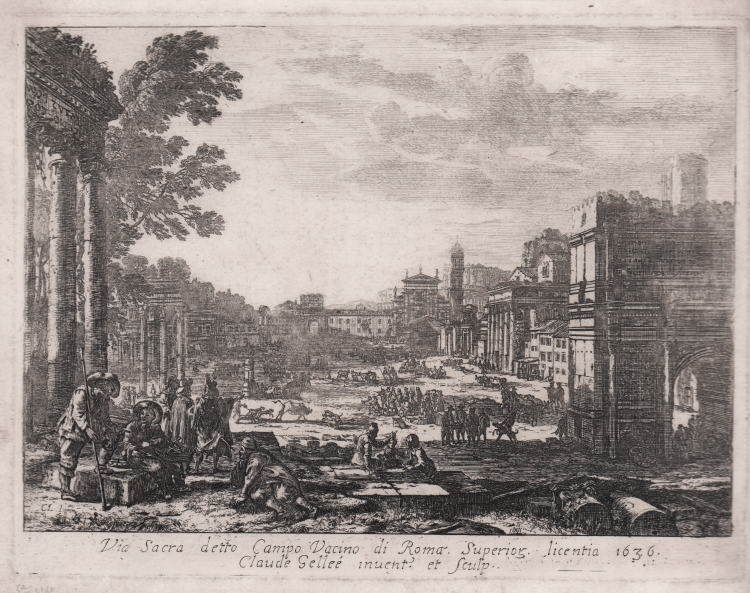



| Reference: | S30698 |
| Author | Claude LORRAINE |
| Year: | 1636 |
| Measures: | 257 x 197 mm |



| Reference: | S30698 |
| Author | Claude LORRAINE |
| Year: | 1636 |
| Measures: | 257 x 197 mm |
Etching, 1636, signed and dated on lower plate. Example in the sixth state of nine.
Good work printed on contemporary laid paper without watermark, with small margins, in excellent condition.
This is the sole engraving belonging to Claude Lorraine that depicts a real view of the city of Rome and derives from a painting of Herman van Swanevelt.
|
Bartsch 17;, Mannocci 17 VI/IX; Le Blanc 3, 23 III/V.
|
Claude LORRAINE (Champagne, Toul, 1600 - Roma 1682)
|
a French painter, draughtsman and engraver of the Baroque era. His actual name was Claude Gellée, but he is better known by the province in which he was born. Orphaned by age of twelve, he went to live at Freiburg with an elder brother, Jean Gellée, a woodcarver. He afterwards went to Rome to seek a livelihood and then to Naples, where he apprenticed for two years, from 1619 to 1621, under Goffredo (Gottfried) Wals. He returned to Rome in April 1625 and was apprenticed to Augustin Tassi. He got into a fight with Leonaert Bramer.In 1627 Lorrain returned to Rome. In 1636 he started cataloguing his works, making tinted outline drawings in six paper books prepared for this purpose of all pictures sent to different countries, and on the back of each drawing he wrote the name of the purchaser. These volumes Claude named the Liber Veritatis.
From about 1637 he rapidly achieved fame as a painter of landscapes and seascapes. He apparently befriended his fellow Frenchman Nicolas Poussin; together they would travel the Roman Campagna, sketching landscapes. In this matter of the importance of landscape, Lorrain was prescient. John Constable described Claude as "the most perfect landscape painter the world ever saw", and declared that in Claude’s landscape "all is lovely – all amiable – all is amenity and repose; the calm sunshine of the heart".
|
|
Bartsch 17;, Mannocci 17 VI/IX; Le Blanc 3, 23 III/V.
|
Claude LORRAINE (Champagne, Toul, 1600 - Roma 1682)
|
a French painter, draughtsman and engraver of the Baroque era. His actual name was Claude Gellée, but he is better known by the province in which he was born. Orphaned by age of twelve, he went to live at Freiburg with an elder brother, Jean Gellée, a woodcarver. He afterwards went to Rome to seek a livelihood and then to Naples, where he apprenticed for two years, from 1619 to 1621, under Goffredo (Gottfried) Wals. He returned to Rome in April 1625 and was apprenticed to Augustin Tassi. He got into a fight with Leonaert Bramer.In 1627 Lorrain returned to Rome. In 1636 he started cataloguing his works, making tinted outline drawings in six paper books prepared for this purpose of all pictures sent to different countries, and on the back of each drawing he wrote the name of the purchaser. These volumes Claude named the Liber Veritatis.
From about 1637 he rapidly achieved fame as a painter of landscapes and seascapes. He apparently befriended his fellow Frenchman Nicolas Poussin; together they would travel the Roman Campagna, sketching landscapes. In this matter of the importance of landscape, Lorrain was prescient. John Constable described Claude as "the most perfect landscape painter the world ever saw", and declared that in Claude’s landscape "all is lovely – all amiable – all is amenity and repose; the calm sunshine of the heart".
|